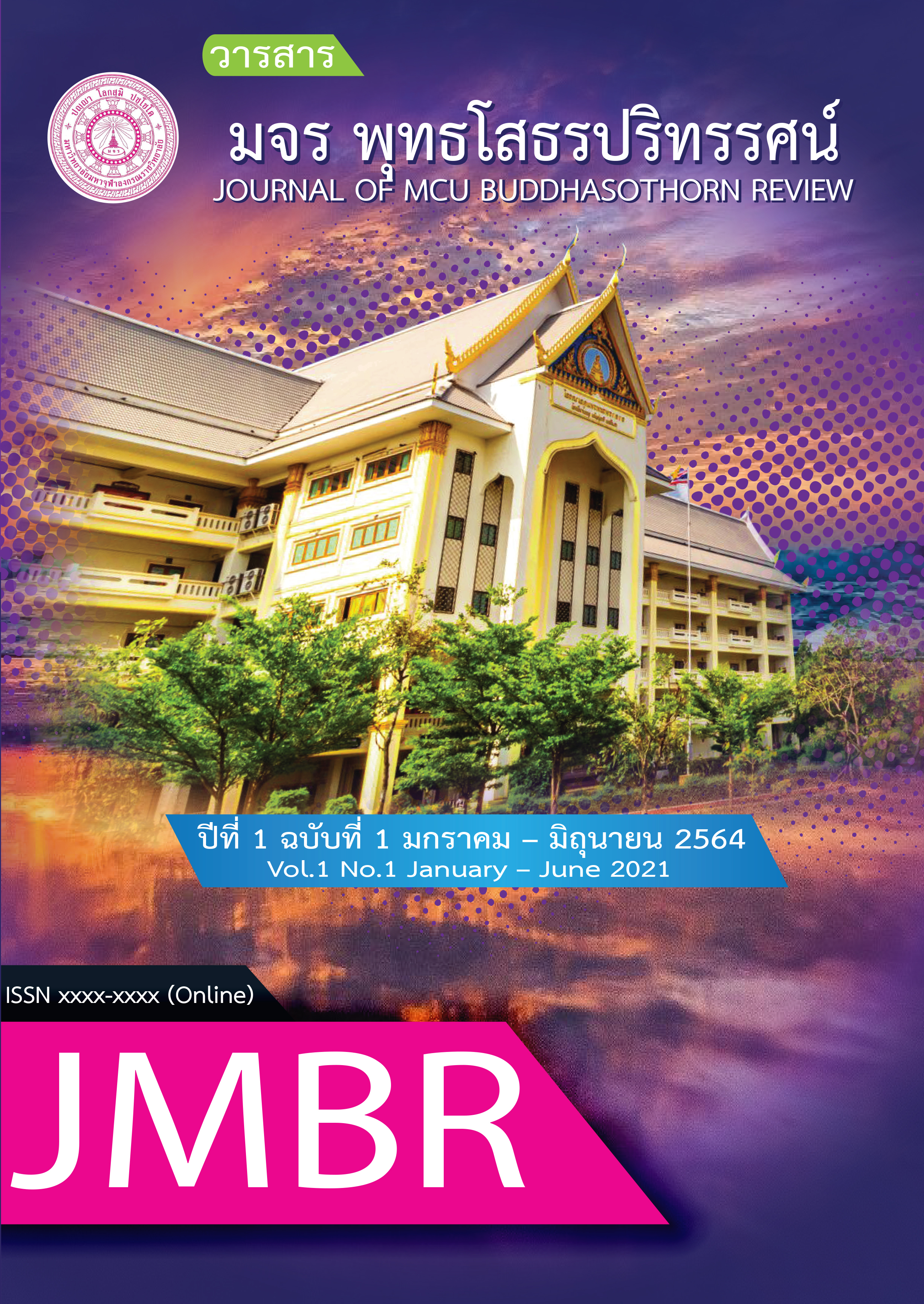Building the potential of individuals to reach Buddhist agriculture along the great aspiration of Amita Bhuddha
Main Article Content
Abstract
Articles “Building the potential of individuals to reach Buddhist agriculture along the great aspiration of Amita Bhuddha” The objective is to study the concept of Building the potential of the individual To access Buddhism agriculture along the great aspiration of the Amita Buddha in Mahayana Buddhism The results of the study concluded that "Mahayana Buddhism thinks that All Bodhisattva came to live the Buddha's life. To hear the Buddha's truth Even though the Lord Buddha has extinguished the end of the last nirvana Still listen to the recitation of the mantra of the late people the name of the Sukhavati world is often present in the Mahayana Sutra. And is often used to represent the ideals that people should have access to Like the ideal of Theravada Buddhists who desire success in the heavens Is the ideal landscape in the next world If only Mahayana Buddhism considered the Sukavadee Buddhism agriculture Is an important destination Intended thatTo be considered in this area of Buddhist agriculture It will be a good opportunity to cultivate the body of Has high performance. It is an important factor in achieving Nirvana in the next time. Su Khao Tiew Yuu Sutra Show the world in all 6 directions, namely east, south, west, north, lower and higher. The Lord Buddha, approximately the same amount as the sand of the Ganges River. Trisahaloslokthat Wimonkiet Nittessut Show the Buddhist agriculture of the Lord Buddha. As for the Saddharmapundarīkasūtra Represents the Buddha statue Whenever the Saddharmapundarīkasūtra is shown Would have formed the Ratana Stupa the Tathagata He is in that Satupa.
Article Details
ต้นฉบับที่ได้รับการตีพิมพ์ในวารสาร มจร พุทธโสธรปริทรรศน์ วิทยาลัยสงฆ์พุทธโสธร มหาวิทยาลัยมหาจุฬาลงกรณราชวิทยาลัย ถือเป็นกรรมสิทธิ์ของวิทยาลัยสงฆ์พุทธโสธร มหาวิทยาลัยมหาจุฬาลงกรณราชวิทยาลัย ห้ามนำข้อความทั้งหมดหรือบางส่วนไปพิมพ์ซ้ำ เว้นเสีย แต่ว่าจะได้รับอนุญาตจากวิทยาลัยฯ เป็นลายลักษณ์อักษร และเพื่อให้เป็นไปตามกฎหมายลิขสิทธิ์ ผู้เขียนทุกท่านต้องลงลายมือชื่อในแบบฟอร์มใบมอบลิขสิทธิ์ บทความให้แก่วารสาร พร้อมกับบทความต้นฉบับที่ได้แก้ไขครั้งสุดท้าย นอกจากนี้ ผู้เขียนทุกท่านต้องยืนยันว่าบทความต้นฉบับที่ส่งมาตีพิมพ์นั้น ได้ส่งมาตีพิมพ์เฉพาะในวารสาร มจร พุทธโสธรปริทรรศน์ เพียงแห่งเดียวเท่านั้น
References
Phoprasitsastara, A. (2008). Mahayana Buddhism. 1st edition. Bangkok: Chulalongkorn University Press.
Xiaocholit, C. (1962). Chinese -Thai Dictionary. Bangkok: Nan Mee Company Limited.
Foundation for the Promotion of Buddhism for Society. (2007). Prayer book Fo Guang SanTemple. Bangkok: Silsiam Packaging and Printing Co., Ltd.
Chen Yixiao, H. (2007). Amitabha and his Paradise. Taiwan: Hongshun Color Printing and Plate Making Co., Ltd.
Dayal,H. (1970). The Bodhisattva Doctrine in Buddhist Sanskrit Literature. Delhi: Motilal Banarsidass.
Lin Guangming-Lin Yixin. (2005). Sanskrit-Chinese Dictionary. Taiwan: Jiafeng Publishing House.
Mahavaipulya mahasamghata sutra. [2020: Online]: http://www.hudong.com/wiki/. [Retrieved 15 January, 2021].
Xiaikeak, P. (2009). Amita Buddhasut And Samanthaphat Chariya Panithanavakha. Bangkok: Shamsayam.
Paul William and Somwang Kaewsupong. (2003). Mahayana Buddhism the basic teachings. Chiang Mai: Mag publisher.
Paul Williams and Anthony Tribe. (2000). Buddhist Thought. London: Rutledge.
Academy, R. (2003). Dictionary of the Royal Institute B.E. 2542. Bangkok: Nanmee Books Publications.
Mahanarongchai, S. (2007). Mahayana Human Language - Dharma Language. Bangkok: Amarin Publishing House.
Mahanarongchai, S. (2007). Mahayana Buddhism (Revised version). 2nd edition. Bangkok: Siam Publishing House.
Bhodhinantha, S. (2000). History of Buddhism. 4th edition. Nakhonpathom: Publisher of Mahamakut.
Sethanang, S. (2004). Do the morning routine - Do the morning routine. Bangkok: M.S. 91 printing.
Jongsanguan, S. (2006). Chanting to do the morning-evening. (Chinese monks, Translate). Bangkok: Thammasat University Press.
Puntharikwat, T. (1983). The Mahayana way. Bangkok: Lynchee Printing Co., Ltd.
Koompai, T. (2012). The Study of the Interpretation of “Sukhavati Buddhaksetra” in Mahayana. A Thesis Degree Master of Arts (Buddhist Studies). Graduate School: Mahachulalongkornrajavidyalaya University.
Inthasara, w. (1998). Mahayana Buddhism. Bangkok: Ramkhamhaeng University Press.
Yengean Bhikkhu and other. (1996). Glossary Department of Buddhism Thai-Bali-Chinese. 2nd edition. Bangkok: Wat Pho Man Kunaram Library.


